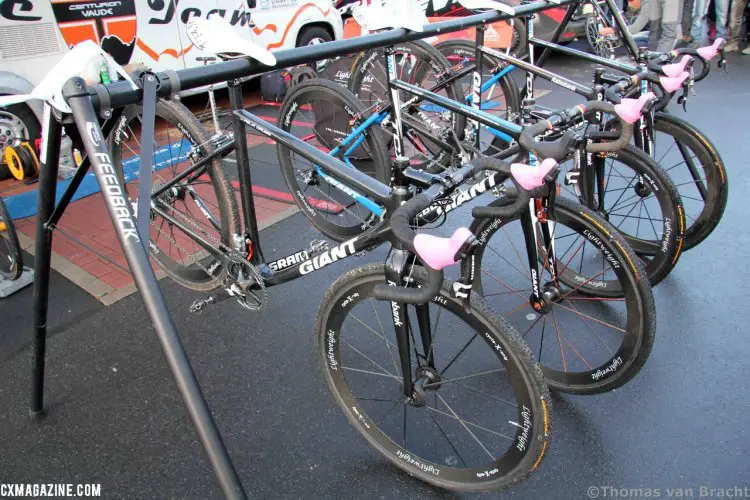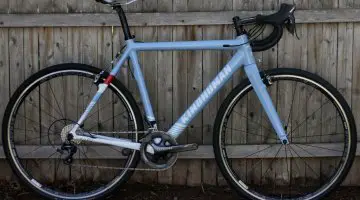It is easy to imagine that sponsorships are reserved for those athletes at the top of their game, with the rest of us mere mortals looking on from the sidelines. However, nothing could be further from the truth. While many pro-level riders work hard for cyclocross to support them, everyone from Elite to amateur club riders can work out partnerships by knowing their strengths and playing to the value they can offer.
Today we’ve included Craig Richey’s full article of hidden tricks to getting sponsored from our Issue 29. For quality content like this, pick up your back copy today, mailed first class, or get a digital version for quicker gratification. Read it here.

Sponsorships are not just about performing at the top level. © Thomas van Bracht / Cyclocross Magazine
by Craig Richey
If your name is Sven Nys or Marianne Vos, sponsorship is probably pretty easy, but for the majority of cyclocross riders and teams, sponsorship is a key off-season project. Add in the gear-intensive nature of cyclocross and the quest for sponsorship might be best described as a feeding frenzy—the rumor of a new team or potential sponsor has the same effect as blood in the water.
As an athlete, I believed that being a friendly guy with solid results was what was required to be a good “ambassador” and sponsored athlete. I was kind of correct and, based on my results, I received roughly the level of sponsorship support that I likely deserved.
Now, sitting on the other side of the fence as the director of marketing at Easton Cycling, I see the quest for sponsorship through a very different lens. This first time it really hit home was at Eurobike and Interbike last year, where just about every conversation went from “Hi, my name is Craig. I do marketing for Easton,” followed by someone saying, “I need free ____.” Pretty much every single pitch was the same: how they are going to do X race or Y event, preceded by a wish list of what gear would be required. Nobody ever said how they were going to help Easton sell more product. It is fairly safe to generalize that every cycling brand wants to achieve the same thing through sponsorship: a positive return on their sponsorship investment. Once you realize what businesses want and how they measure success, it is much easier to present an enticing sponsorship proposal and execute on it so that everyone is happy.
Sponsorship of any rider, team, or event only makes sense for a cycling brand if it achieves one of a three objectives.
The standard pitch of John Smith being “a really nice guy and a great ambassador” might work for getting a discount, but doesn’t mean John deserves free stuff. With any sponsored athlete, professionalism and positive personality isn’t a benefit, it’s an expectation.
The other standard pitch of “product testing and feedback” is a pretty weak sell. Every brand worth their mettle has a test lab and a network of seasoned test riders that have ridden a large number of similar products and have a track record of finding the subtle nuances between product iterations. Instead, focus on achieving one of the four above objectives. If you can convince me that you will accomplish one of them, it would be a smart business decision for me to sponsor you.
Play to Your Strengths
Now that you know what sponsors look for, the next step is to figure out how to deliver. As in racing, it is important to know your strengths and weaknesses and pull the most value from the former. If you are a great technical rider, you want to hit the technical sections at the front of the group to put everyone else into difficulty—not attack on the road, where everyone can sit on your wheel.
Coming up with a compelling sponsorship proposal should use a similar tactic. If you work at a bike shop that sells a lot of high-end wheels, it could make sense to target objective number one and talk to a wheel brand, instead of trying to build a social media following from nothing to achieve objective number two. It is possible to combine objectives, but if you target them all, it sounds like you are trying to achieve everything, and the cynic in most marketing managers will assume you won’t accomplish any of them.

Club or professional teams, Elite or Juniors, both have the opportunity to partner with the right companies. © Andrew Yee / Cyclocross Magazine
Target the Right Market
If you are a junior, regional club, or local ripper, your value and market is far different from someone who is racking up UCI wins. For those junior and regional club riders, the best starting point is to begin building a relationship with your local bike shop. You’re probably not going to get free stuff from anyone, but your shop can put you in contact with the brand reps they support who will in turn set you up with grassroots- and ambassador-level sponsorship. This gets the ball rolling and begins building a solid relationship. Be supportive on social media, “like” and “re-gram” their posts, post pictures of you representing their brand, and, over time, their support will come.
For the pro riders and major teams, again, know your value and be realistic. A regional cyclocross team contacted me last summer with their product request list for 45 carbon wheelsets—a request not even within the ballpark of “reasonable.” My immediate question was, “Is sponsoring a regional team based out of Kansas likely going to result in Easton selling 300 additional sets of carbon wheels?” The answer: it’s unlikely. It is better to be the star athlete for a small- to mid-sized brand than to be far down the priority list for a huge company. If you are a solid regional professional cyclist, winning some UCI races for a brand like Van Dessel or Norco will likely result in them promoting you and using you in their ads, which is going to get you and your other sponsors additional publicity. If the same rider was racing for Trek or Specialized, those brands are unlikely to talk about or promote the accomplishments of that rider to the same degree.
Here is an example of how I would position myself to sponsors: I don’t do much on social media, but my position at Easton and my race calendar give me good reach, so I will target Objective #2. I raced a mix of UCI and local races last year and was fairly dominant in British Columbia, so I would provide the most value results-wise for a brand that is primarily focused on BC. I would target companies that are interested in the BC cycling market with my strong local presence in said community. At Easton, I end up being a last-minute stand-in for our advertisements, and try to include my sponsors when they complement the promoted product. This generates a lot of high value reach for my sponsors.
Build a Relationship from the Ground Up
The holy grail of cycling sponsorship is securing resources from outside the industry. This is where the real money and support lies, but is surprisingly hard considering the cycling market should be extremely attractive to many businesses: cyclists are an educated, high-income demographic who are passionate about their sport and loyal to the brands that support it. So many companies view the “cyclist” demographic as their ideal consumer, but few companies market to them as cyclists.
Cycling is still a fringe sport and cyclocross even more so, but for a company trying to reach the healthy-living, upper-middle class consumer, sponsoring a high-level ’cross team in North America is an unbelievably good value. Take for example Noosa. I don’t think many people had ever heard of that brand until last year when they sponsored Allen Krughoff and Meredith Miller. That sponsorship didn’t cost that much, and now 100,000 cyclocross racers in America know that brand and actively seek it out in their local grocery stores.
Because cyclocross is not mainstream, a cold call or email sponsorship pitch is going to have a low success rate. You need to cultivate relationships with the right people and educate them about cyclocross. From there, it will be clear that if educated, high-income consumers are their market, sponsoring cyclocross is the best way to reach them.
While some riders and teams understand sponsorship and the objectives of the businesses they represent, the vast majority of riders doing the off-season sponsorship hustle really don’t get it. If you play to your strengths and focus on the prospective sponsor’s business objectives, you will stand out from the crowd.
Track me down at Interbike, a local race or online—I am still waiting to hear the perfect pitch.




























